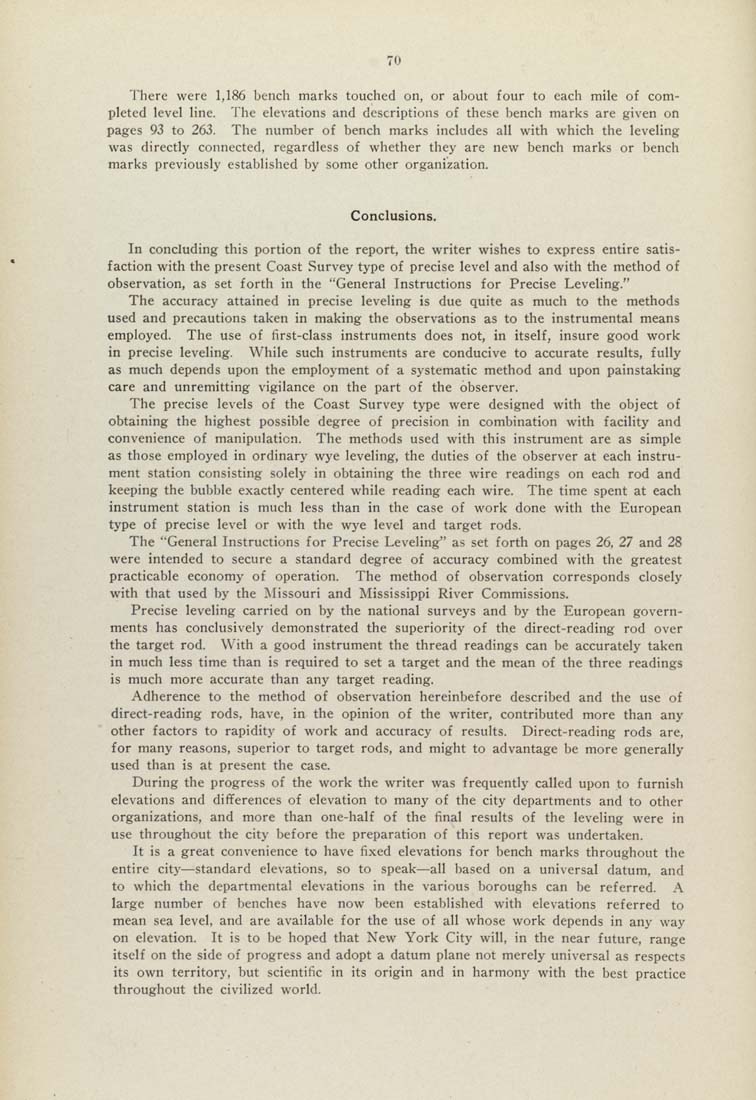70
There were 1,186 bench marks touched on, or about four to each mile of com¬
pleted level line. The elevations and descriptions of these bench marks are given on
pages 93 to 263. The number of bench marks includes all with which the leveling
was directly connected, regardless of whether they are new bench marks or bench
marks previously established by some other organization.
Conclusions.
In concluding this portion of the report, the writer wishes to express entire satis¬
faction with the present Coast Survey type of precise level and also with the method of
observation, as set forth in the "General Instructions for Precise Leveling,"
The accuracy attained in precise leveling is due quite as much to the methods
used and precautions taken in making the observations as to the instrumental means
employed. The use of first-class instruments does not, in itself, insure good work
in precise leveling. While such instruments are conducive to accurate results, fully
as much depends upon the employment of a systematic method and upon painstaking
care and unremitting vigilance on the part of the observer.
The precise levels of the Coast Survey type were designed with the object of
obtaining the highest possible degree of precision in combination with facility and
convenience of manipulation. The methods used with this instrument are as simple
as those employed in ordinary wye leveling, the duties of the observer at each instru¬
ment station consisting solely in obtaining the three wire readings on each rod and
keeping the bubi)le exactly centered while reading each wire. The time spent at each
instrument station is much less than in the case of work done with the European
type of precise level or with the wye level and target rods.
The "General Instructions for Precise Leveling" as set forth on pages 26, 27 and 28
were intended to secure a standard degree of accuracy combined with the greatest
practicable economy of operation. The method of observation corresponds closely
with that used by the Missouri and Mississippi River Commissions.
Precise leveling carried on by the national surveys and by the European govern¬
ments has conclusively demonstrated the superiority of the direct-reading rod over
the target rod. With a good instrument the thread readings can be accurately taken
in much less time than is required to set a target and the mean of the three readings
is much more accurate than any target reading.
Adherence to the method of observation hereinbefore described and the use of
direct-reading rods, have, in the opinion of the writer, contributed more than any
other factors to rapidity of work and accuracy of results. Direct-reading rods are,
for many reasons, superior to target rods, and might to advantage be more generally
used than is at present the case.
During the progress of the work the writer was frequently called upon to furnish
elevations and differences of elevation to many of the city departments and to other
organizations, and more than one-half of the final results of the leveling were in
use throughout the city before the preparation of this report was undertaken.
It is a great convenience to have fixed elevations for bench marks throughout the
entire city-—standard elevations, so to speak—all based on a universal datum, and
to which the departmental elevations in the various boroughs can be referred. A
large number of benches have now been established with elevations referred to
mean sea level, and are available for the use of all whose work depends in any way
on elevation. It is to be hoped that New York City will, in the near future, range
itself on the side of progress and adopt a datum plane not merely universal as respects
its own territory, but scientific in its origin and in harmony with the best practice
throughout the civilized world.
|








